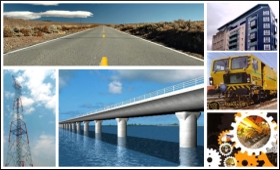|
|
|

|
Two focal points to boost investments and infrastructure
|
|

|
|
| Top Stories |
 |
|
|
|
SME Times News Bureau | 04 Jun, 2019
Two keywords that will define the investment climate and encourage more
investments in India are "balance and focus". And the common factor
between the two keywords is the concept of transparent and rational
pricing.
"Balance" refers to the balance between the government's
role as a financier and facilitator of investments. While the
clamouring seems to be for the government to loosen its purse strings to
boost infrastructure creation and job growth, one must be mindful that
given the size of the Indian economy there are limitations regarding how
much of new investments can be financed utilising government spending.
Nonetheless, government spending is essential, but so is the
government's role as a facilitator of investments. Therefore, it is
vital that the government lays out a plan regarding sectors in which it
wants to be the principal financier of assets like perhaps highways and
areas where it will be a facilitator of investments through policy
measures such as in urban healthcare infrastructure.
Even in the
highway sector, space is limited as the debt burden of the NHAI stood at
Rs 1.48 lakh crore in September 2018, while the Bharatmala projects
will require an additional approximately Rs 2 lakh crore in the next
five years. The debt level highlights the need for securing new sources
for funding beyond debt and government budgetary allocations, even in
sectors such as highways. Monetisation via asset sales and leases of
toll-producing highways will have to gather momentum. To succeed with
rapid asset monetisation, transparency in the process and rationality
around asset pricing hold the key.
For sure, the cornerstone of
boosting investment will continue to be on the ability of the government
to balance its role as a financier and facilitator of infrastructure.
For example, building roads is crucial, but so is efficiently finding
avenues to finance the assets. Most importantly, given the investment
requirement, expecting the government to shoulder the entire burden of
financing infrastructure solely is not feasible in the long-run.
The
other keyword that needs attention is "focus", especially with a view
on Public Sector Units (PSUs). While calls have been made for the
privatisation of PSUs, the key is to decide on the path forward for PSUs
in general. While privatisation for certain businesses makes sense,
running PSUs more efficiently must also be an option worthy of
consideration. Those PSUs that require privatisation, the attention to
transparent and rational pricing is critical. Lessons from the
experience of the unsuccessful attempts to auction off Air India last
year are particularly important. The market requires clarity around both
asset quality and business control. Therefore, successful
privatisations will need the government to have clarity around the asset
price as well as the transfer of control for the asset to the new
investor.
Making an asset appealing does not necessarily mean
ceding excessive value to the buyers; on the contrary attractive assets
deliver value for both the seller and the buyer. The careful analysis of
asset attractiveness will assist the overarching process of
privatisation of PSUs. Questions must be asked regarding why a private
player will be interested in an asset? Assets encumbered by significant
human capital costs and debt will struggle to find takers. Therefore, a
transparent auction process that accounts for market value will be
essential.
However, not all PSUs have to be privatised to
succeed. As the likes of Energy Efficiency Services Limited (EESL) have
shown, PSUs can be profitable, innovative and create significant value
in crucial areas. The recent results by EESL, wherein fiscal 2019 a
revenue growth of 37 per cent on a year-on-year basis was registered
while net profit increased by 214 percent, demonstrate that a well run
PSU has significant value-creating potential. Essentially, therefore,
decisions need to be taken to delineate the PSUs into three categories:
(i) those that can be run profitably, (ii) those that have significant
social and economic value but may not always be financially profitable,
and (iii) finally those that are better run by the private sector.
As
India looks to create an investment climate to boost economic growth in
the decades ahead, the government's role will be vital for obvious
reasons. A strategy that seeks to balance its role as a financier and
facilitator with a focus on the right sectors will go a long way in
boosting the capacity of the government to provide a significant impetus
to the economy.
|
|
|
| |
|
|
|
|
|
|
|
|
|
|
|
|
|
|
| |
| Customs Exchange Rates |
| Currency |
Import |
Export |
US Dollar
|
84.35
|
82.60 |
UK Pound
|
106.35
|
102.90 |
Euro
|
92.50
|
89.35 |
| Japanese
Yen |
55.05 |
53.40 |
| As on 12 Oct, 2024 |
|
|
| Daily Poll |
 |
 |
| Do you think Indian businesses will be negatively affected by Trump's America First Policy? |
|
|
|
|
|
| Commented Stories |
 |
|
|
|
|
|
| |
|